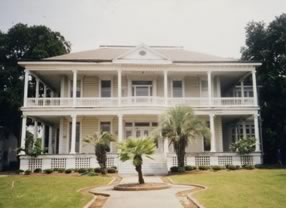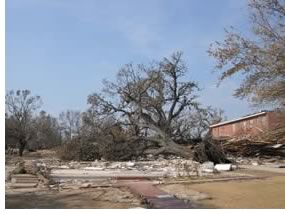

09/2005
by
Matt Hyde
Federal Legislative Analyst
To help repair and rehabilitate the thousands of historic homes caught in the path of Hurricane Katrina, the National Trust for Historic Preservation and the AIA are working on securing the reintroduction of the Historic Homeownership Assistance Act. This bill was first introduced in the 107th Congress in 2001 by former Sen. John Breaux (D-La.) and Rep. Clay Shaw (R-Fla.).
 The Historic Homeownership Assistance Act would allow homeowners who
occupy their dwellings to qualify for a 30 percent tax credit for rehabilitating
or repairing their historic property affected by Hurricane Katrina. The
State Historic Preservation Officer would certify that the expenditures
are consistent with the Secretary of the Interior’s “Standards
for Historic Preservation” and meet the qualifications of the preservation
law. The property would have to be “substantially rehabilitated” to
qualify for the credit, so a minimum of $5,000 must be spent on the repairs.
Lastly, the proposal recognizes that disaster-related circumstances will
preclude some individuals from taking advantage of the credit, so there
is a provision that would allow low-income homeowners to receive a refund
in excess of their tax liability.
The Historic Homeownership Assistance Act would allow homeowners who
occupy their dwellings to qualify for a 30 percent tax credit for rehabilitating
or repairing their historic property affected by Hurricane Katrina. The
State Historic Preservation Officer would certify that the expenditures
are consistent with the Secretary of the Interior’s “Standards
for Historic Preservation” and meet the qualifications of the preservation
law. The property would have to be “substantially rehabilitated” to
qualify for the credit, so a minimum of $5,000 must be spent on the repairs.
Lastly, the proposal recognizes that disaster-related circumstances will
preclude some individuals from taking advantage of the credit, so there
is a provision that would allow low-income homeowners to receive a refund
in excess of their tax liability.
 “Although this legislation only touches a small portion of the
horrendous human and environmental problems caused by the hurricane and
its aftermath,” said Ron Faucheux, team vice president, AIA Government
Advocacy, “it’s something Congress can do immediately that
will help the restoration process. New Orleans and the entire Gulf Coast
contain a treasure trove of historic structures, many of them used for
housing. Historic preservation is vital to the nation and an important
value of the AIA.”
“Although this legislation only touches a small portion of the
horrendous human and environmental problems caused by the hurricane and
its aftermath,” said Ron Faucheux, team vice president, AIA Government
Advocacy, “it’s something Congress can do immediately that
will help the restoration process. New Orleans and the entire Gulf Coast
contain a treasure trove of historic structures, many of them used for
housing. Historic preservation is vital to the nation and an important
value of the AIA.”
According to former Louisiana Sen. John Breaux, “The number of properties eligible for the historic homeowners credit [in Louisiana] is approximately one third of the almost one million structures in historic districts nationwide, and 58 percent are located in census tracts with a poverty rate of 20 percent or greater. In Louisiana, 91 percent of the historic districts in the state overlap with census tracts with a rate of poverty of 20 percent or more—a figure much higher than the national average . . . In a recent National Park Service survey, it was found that 109 National Register Historic Districts in the state contain 45,084 historic buildings.” (Congressional Record Page S.5276 May 21, 2001.)
Copyright 2005 The American Institute of Architects.
All rights reserved. Home Page ![]()
![]()
 |
||
This article is reprinted from the AIA Angle, the semi-weekly e-mail news service of the AIA Government Advocacy Team. The National Trust for historic Preservations Web site offers downloadable manuals for treatment of flood-damaged historic buildings. Pictured in before-and-after-Katrina photos is the Dantzler House in Biloxi, which had just been remodeled to house a Mardi Gras Museum. Photos courtesy of the Mississippi Heritage Trust. Visit the Web site to view more photos.
|
||